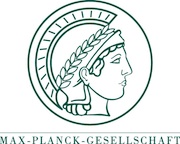The following is an overview of my research on few- and many-body phenomena in ultra-cold atomic gases. An underlying theme is the cross-fertilization of ideas between different branches of science, using for example Bose-Einstein condensates as analog system for curved space-time quantum field theory or arrays of Rydberg atoms to study questions relevant to photosynthesis or chemistry.
Rydberg aggregates
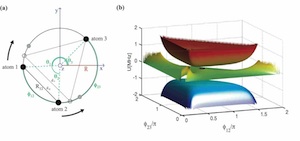 Transfer of electronic excitations on chains of atoms or molecules (aggregates) is important in many areas of physics, such as photosynthetic light-harvesting, organic dye-aggregates or assemblies of Rydberg atoms in optical lattices.
The electromagnetic interactions responsible for excitation propagation also exert mechanical forces on the chain, inducing motion of the constituents.
Transfer of electronic excitations on chains of atoms or molecules (aggregates) is important in many areas of physics, such as photosynthetic light-harvesting, organic dye-aggregates or assemblies of Rydberg atoms in optical lattices.
The electromagnetic interactions responsible for excitation propagation also exert mechanical forces on the chain, inducing motion of the constituents.
We have shown how the interplay between excitonic and atomic motion can yield adiabatic entanglement transfer through a linear chain of Rydberg atoms.
If the atoms are instead arranged on a circule, the system exhibits conical intersections with all the interesting consequences that they entail.
Alexander Eisfeld
Jan-Michael Rost
Bose-Einstein condensates
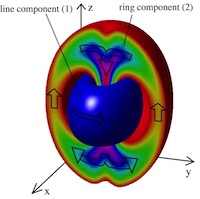 Bose-Einstein condensates (BECs) are an excellent system to study complicated phenomena emerging from well understood microscopic physics.
They also allow very extremely fine experimental control over system parameters.
For our studies of them our workhorse is condensate mean field theory, but we also consider quantum corrections in the Hartree-Fock-Bogoliubov and truncated Wigner theories.
Bose-Einstein condensates (BECs) are an excellent system to study complicated phenomena emerging from well understood microscopic physics.
They also allow very extremely fine experimental control over system parameters.
For our studies of them our workhorse is condensate mean field theory, but we also consider quantum corrections in the Hartree-Fock-Bogoliubov and truncated Wigner theories.
The list of our topics is diverse:
- We investigated possible quantum effects in condensate collapse due to attractive interactions ("Bosenova").
- We have found requirements for the experimental creation of Skyrmions. These are topological solitons, which for example took part in the recent story of prediction, discovery and dispute of the pentaquark in particle physics.
- We proposed the stabilisation of ring vortices using optical tunnels through which the BEC flows.
- We studied quantum effects on the genesis of bright solitons in the wake of a condensate collapse.
- We surveyed prospects of studying the quantum-classical transition in quantum chaos using condensates in magnetic microtraps.
- We analysed Kerr-squeezing in Bose-Einstein condensates and homodyne methods for its detection.
Craig Savage
Matthew Davis
Stochastic quantum field theory
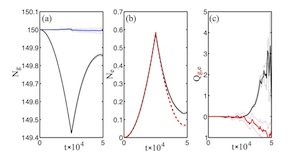 The Hilbert-space size problem usually preventing first-principles simulations of quantum many-body systems can be overcome for short times using stochastic gauge methods.
The essential trick here is the mapping of quantum-correlations to correlations of complex random variables in a large ensemble. It allows the reduction of the computational size of an N-particle, M-mode problem from the
quantum mechanical M^N to merely M, albeit with the need of treating a large stochastic ensemble.
The Hilbert-space size problem usually preventing first-principles simulations of quantum many-body systems can be overcome for short times using stochastic gauge methods.
The essential trick here is the mapping of quantum-correlations to correlations of complex random variables in a large ensemble. It allows the reduction of the computational size of an N-particle, M-mode problem from the
quantum mechanical M^N to merely M, albeit with the need of treating a large stochastic ensemble.
The available simulation time is limited by onset of exponential increase of the simulation's noise content. This time-span can be lengthened, by the use of drift and adaptive diffusion gauges, which we aim to generalize to systems with long-range interactions.
Piotr Deuar
Joel Corney.
Analogue gravity
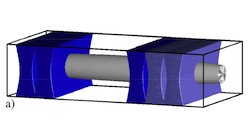 It has been realized that the same laws of nature govern quantum particle propagating in a curved space-time (such as near a black hole) and sound-waves propagating in a moving, cold quantum-fluid.
Roughly speaking, the location where the background flow velocity turns super-sonic represents a point of no return for the sound wave, just as the event horizon of the black hole does for the particle.
It has been realized that the same laws of nature govern quantum particle propagating in a curved space-time (such as near a black hole) and sound-waves propagating in a moving, cold quantum-fluid.
Roughly speaking, the location where the background flow velocity turns super-sonic represents a point of no return for the sound wave, just as the event horizon of the black hole does for the particle.
Bose-Einstein condensates are a promising fluid in which this could be exploited, due to their extremely low temperatures and precise experimental control over them.
One ultimate goal would be the experimental verification of (analog) Hawking radiation. We have pointed out the importance of carefully considering classical and quantum effects due to
three-body losses for any such endeavour.
Craig Savage
